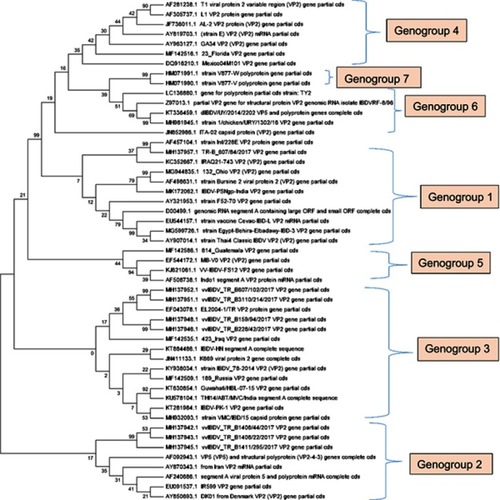Figures & data
Figure 1 Phylogenetic analysis of the nucleotide sequences of hVP2 infectious bursal disease virus (IBDV). The evolutionary history was inferred using the Neighbour-Joining method. The bootstrap consensus tree inferred from 1,000 replicates is taken to represent the evolutionary history of the taxa analyzed. Branches corresponding to partitions reproduced in <50% bootstrap replicates are collapsed. The percentage of replicate trees in which the associated taxa clustered together in the bootstrap test (1,000 replicates) is shown next to the branches. The evolutionary distances were computed using the Maximum Composite Likelihood method and are in the units of the number of base substitutions per site. The analysis involved 51 nucleotide sequences. Codon positions included were 1st + 2nd + 3rd + noncoding. All positions containing gaps and missing data were eliminated. There were a total of 336 positions in the final dataset. Evolutionary analyses were conducted in MEGA7.Citation90

Table 1 Recent development in IBDV vaccines research
Figure 2 Transmission electron micrograph of cesium chloride gradient purified Infectious bursal disease virus (IBDV) virus protein 2 (VP2) subviral particles (SVPs), negatively stained with sodium phosphotungstate. Reprinted from.Citation43 Copyright 2009, with permission from Elsevier. Bar = 100 nm.

Figure 3 An overview of 60 years of infectious bursal disease (IBD) research.Abbreviations: IBDV, Infectious bursal disease virus; HVT, Herpesvirus of Turkey; VP2, virus protein 2; cHSP70, C-terminal domain of heat shock protein 70 of Mycobacterium tuberculosis; CAM, Chorioallantoic membrane; OIE, Office International des Épizooties [World Organisation for Animal Health].
![Figure 3 An overview of 60 years of infectious bursal disease (IBD) research.Abbreviations: IBDV, Infectious bursal disease virus; HVT, Herpesvirus of Turkey; VP2, virus protein 2; cHSP70, C-terminal domain of heat shock protein 70 of Mycobacterium tuberculosis; CAM, Chorioallantoic membrane; OIE, Office International des Épizooties [World Organisation for Animal Health].](/cms/asset/41db1512-b5ee-444c-95e2-4116540df4cc/dvmr_a_185159_f0003_c.jpg)
